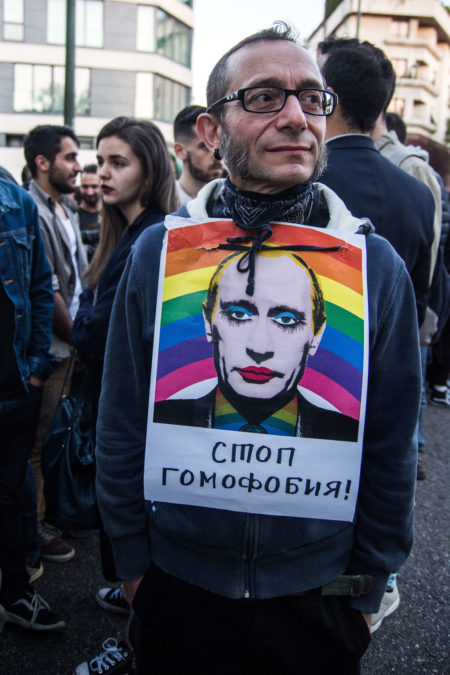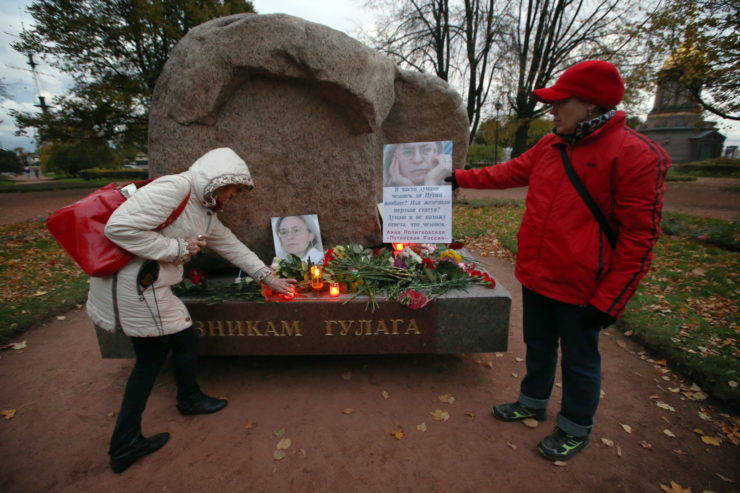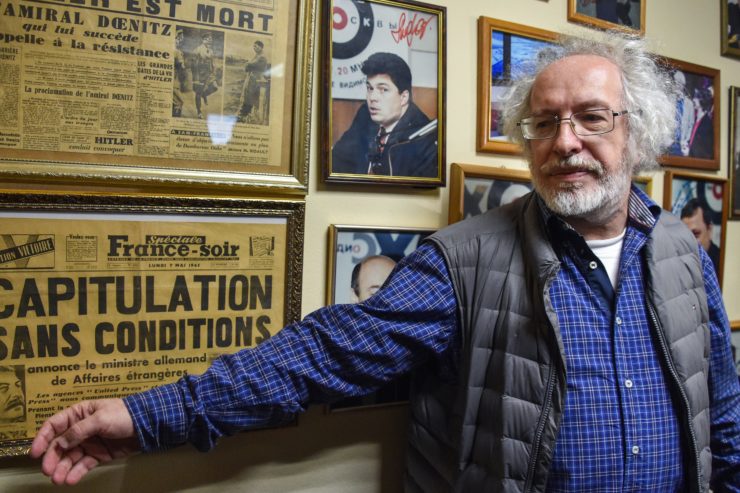In March Elena Milashina, a reporter for Russia’s leading independent newspaper Novaya Gazeta, was tipped off by a source about the suspicious death of a man in Chechnya. Through her reporting, Milashina, who had been covering Chechnya for more than a decade, learned that the victim was tortured to death in a secret detention center.
Extrajudicial detentions are widespread in this North Caucasus republic, which for centuries has fought for independence from Russia. So Milashina wasn’t surprised to get a tip about an illegal detention and murder. What was unprecedented about this case was the reason for the arrest: The man was gay.
“Usually people are detained on the grounds of terrorism or drugs,” she says. “So I was very careful about checking this information.”
Milashina spoke to sources in the police, the Chechen leader’s administration, the Russian secret service (FSB), and the prosecutor’s office, and she talked to local activists. They all pointed to an orchestrated campaign of anti-gay repression in Chechnya. Since February, about 100 men had been detained and at least three had been killed. Milashina published the first story without direct evidence from survivors.
Novaya Gazeta partnered with the Russian LGBT network to launch a hotline for those affected, and people started reaching out. Days later, the paper printed a story, co-bylined by Milashina and Irina Gordienko, based on the evidence of a few gay men who had fled persecution in Chechnya. All of them reported being beaten and tortured at the same secret detention center in the city of Argun.
Milashina’s reporting caused global outrage. Follow-up stories were published in Western media outlets, including The Guardian, The New York Times, and The Washington Post.
The response in Chechnya was outrage of a different sort. Fifteen thousand people gathered at a mosque in Grozny, the Chechen capital, and encouraged retaliation against the staff of Novaya Gazeta, with clerics declaring, “We promise that the true instigators will be subjected to retribution, wherever and whoever they are, without the statute of limitations.” The newspaper’s editorial board condemned the statement, saying, “It is obvious to us that this resolution is pushing religious fanatics to massacre journalists.” Milashina fled Russia out of concern for her safety.
The way the persecution of gay men in Chechnya was—or wasn’t—covered in Russia is a vivid example of the country’s polarized media landscape
Novaya Gazeta wasn’t the only Russian outlet to cover the scandal. Despite threats of death, persecution and “Allah’s retribution” from Chechen authorities, a number of mid-sized newsrooms published evidence of the detentions and interviewed survivors. Yet major government-controlled media, like TV stations Channel One and Rossiya-1 ignored the story—with one exception. A terse article in tabloid daily Komsomolskaya Pravda, headlined “Gays for Export,” presented the torture reports as a concocted Western provocation against the nation.
The way the persecution of gay men in Chechnya was—or wasn’t—covered in Russia is a vivid example of the country’s polarized media landscape. Independent news outlets uneasily coexist with state propaganda mouthpieces, each offering sharply different pictures of the country and each speaking to starkly different audiences. While independent journalists report on purges in Chechnya and mass protests across Russia’s biggest cities, the much more widely read state-controlled media report on growing GDP, President Vladimir Putin’s achievements, and Western conspiracies against Russia.
“The choice is very simple,” says Milashina. “If you want to be a journalist, you work for [independent business news outlet] RBC or Novaya Gazeta. If you want to be nothing of the sort, go to the federal media,” as Russia’s government-run outlets are called.

While independent outlets and online platforms still publish important stories, and the murder rate for journalists has fallen in recent years, Russia remains one of the most dangerous countries in the world to be a reporter. Newsrooms are routinely ordered to remove editors who displease the state. Sometimes the government orders the sale of troublesome outlets to Kremlin-friendly owners or pressures advertisers to withhold business. Starting last year, foreign ownership of media outlets has been limited to 20 percent. As a result, Pearson and Dow Jones sold their stakes in business daily Vedomosti (“The Record”) to a Russian owner.
Since 1992, 58 journalists have been killed in Russia; two so far this year, according to the Committee to Protect Journalists. In October, Tatyana Felgenhauer, deputy editor of the Ekho Moskvy radio station, was stabbed in the neck by an intruder in the station’s Moscow studio. Another Ekho Moskvy reporter, Yulia Latynina, left the country earlier this year after an arson attack on her car. Russia ranks 148th out of 180 countries on Reporters Without Borders’ press freedom index.
During the early 1990s, after the collapse of the Soviet Union, Russian journalism enjoyed a period of relative freedom. Reporters dug into newly opened archives and chronicled the crimes of Soviet leadership. Around the same time, journalists were routinely targeted for assassination. The most notorious case since Putin became president in 2000 was the murder of Anna Politkovskaya, Novaya Gazeta’s special correspondent and a human rights activist. An outspoken critic of Russian policies in Chechnya, Politkovskaya was shot in her apartment building in downtown Moscow on October 7, 2006. Unlike earlier murders of journalists, Politkovskaya’s assassination was well-investigated, with six perpetrators sentenced to prison terms. Who ordered the killing is still unknown.
Television remains the dominant medium in Russia. Channel One and Rossiya-1—two of the three major channels with nationwide reach—are controlled by the state, while the third, NTV, is owned by state-controlled oil and gas company Gazprom. Though the internet is less tightly controlled than traditional mass media outlets, the Kremlin is increasingly working to muzzle independent online outlets. A 2014 law forces popular bloggers to register with media watchdog Roskomnadzor, essentially equating any blog with more than 3,000 daily readers with a news outlet and rendering it liable to restrictions. Legislation also allows authorities to blacklist websites without explanation and, after the growing influence of alternative platforms became evident this spring, the Kremlin is thwarting anonymous messaging services, such as Telegram, and banning virtual private networks (VPNs), which help users get access to blocked websites.
All this is in addition to the elaborate network of state-sponsored troll farms that deluge online spaces with fake news. A recent study by the Oxford Internet Institute found that, in a sample of 1.3 million accounts regularly tweeting about Russian politics between 2014 and 2015, some 45 percent—585,000—were Russian bots. Meanwhile, both Facebook and Twitter reported in September that numerous accounts linked to Russian operatives sought to influence political discourse during the 2016 presidential campaign. Twitter announced in late October that it had banned Sputnik and Russia Today (RT) from advertising on the social network, based on Twitter’s findings that the two media firms had attempted to interfere with the election on the Russian government’s behalf. Also in late October, Paul Manafort, President Donald Trump’s former campaign chairman, was charged with tax fraud and money laundering in connection with an investigation concerning Russia and attempts to influence the 2016 presidential election.
State-controlled media, such as Channel One inside Russia and RT abroad, including RT’s YouTube channel, which has 2.2 million subscribers, produce content difficult to distinguish from legitimate news. Channel One regularly featured comments from “American political expert” Greg Vainer—until the spring when he was correctly identified as Russian businessman Gregory Vinnikov, who is accused of fraud in the U.S. In early 2016, RT coverage of the alleged rape by Arab migrants of a teenage Russian-German girl living in Berlin caused a diplomatic scandal before it was proved to be false.
“Propaganda in the state media is extremely efficient,” says Tatyana Lokshina, Russia program director and senior researcher at Human Rights Watch. “It’s not an old-school Soviet propaganda, which was gray and dreary. There is a persuasive story being told and experts commenting on it. And a viewer buys this story because he has a complete illusion that he is dealing with high-quality information. He doesn’t know that the story is not true, and the experts are not the real experts in their fields.”
The reach of the state-controlled media far outpaces that of independent outlets. An independent outlet might have an average monthly audience of five to eight million; Channel One has 250 million. Still, in addition to Novaya Gazeta, online TV channel Dozhd, the Meduza website, and Ekho Moskvy radio station continue to expose corruption, human rights violations, and Russian proxy wars abroad. And, while these outlets struggle to avoid state pressure, reporters are increasingly using YouTube, encrypted messaging services like Telegram, and good old-fashioned email newsletters to disseminate news and information.
Independent news outlets uneasily coexist with state propaganda mouthpieces, each offering sharply different pictures of the country
During Putin’s time, control over the mass media has mostly been exerted by administrative and financial means. Increasingly, independent media have been targeted with restrictive legislation intended to curtail dissent and negative reporting about the Kremlin. In the summer of 2016, Putin signed legislation that, though aimed at terrorism, includes policies limiting free expression. The law requires Internet service providers to retain, archive, and provide authorities access to users’ communications data.
Pressure is brought to bear on media owners, forcing them to change editors and editorial policy or to sell their companies to businessmen with close ties to the Kremlin. In journalistic slang, this process is known as razgrom, from the word “pogrom,” signifying defeat or violent destruction.
One of the first razgroms in the Putin era happened to NTV, once the most popular independent TV channel. In 2001, NTV was handed over to Gazprom-Media, the subsidiary of oil-gas giant Gazprom, which has close ties to the Kremlin. Journalists protested with rallies and open letters. Staff seized the studios and broadcast their occupation live. The mutiny failed, however. NTV, once famous for political satire and independent investigations, began churning out bland Russian cop shows, occasionally interrupted by news and talk shows transmitting the Kremlin line.
“We believed it was possible to turn the tide by protesting,” says Simon Saradzhyan, former deputy editor of the Moscow Times newspaper and founding director of the Russia Matters Project at the Harvard Kennedy School's Belfer Center, which provides analysis of Russian politics. “But since then, it has happened so many times that it became clear it isn’t.”

Pavel Kanygin, a special correspondent for Novaya Gazeta, is one of the very few journalists consistently and deeply investigating Russia’s role in the Eastern Ukraine conflict. This spring he managed to identify a commander responsible for the downing of the MH17 aircraft over Ukraine in 2014. “I do my job,” he says. “Maybe in some other media outlet I would feel discomfort covering such issues as the war in Ukraine, the investigation of the downing of MH17, or the presence of Russian special forces in Donbass. But, working at Novaya Gazeta, I don’t have any problem with that.”
That may be because few people actually read Novaya Gazeta. Kanygin bitterly describes himself and other independent journalists as “pathetic reminders of the free press scrabbling around in our small garden,” while mainstream opinion in the country is molded by state-controlled propaganda. The limited reach of independent outlets may be the reason Putin allows them to exist at all. “Our authority doesn’t want to officially turn into a totalitarian regime,” Kanygin says. “That’s why it is important for [Putin] to preserve the facade of this allegedly democratic order.”
The only remaining large independent media holding company, RosBusinessConsulting (RBC), is experiencing razgrom now. The process started in 2014, when RBC published a story revealing that the chairwoman of an obscure high-tech fund called Innopraktika, which handled contracts worth billions of dollars, was actually Putin’s daughter. In May of last year, Elizaveta Osetinskaya, chief editor of the RBC media conglomerate, which includes a TV station, business newspaper, and a widely read political news site, and two of her deputies were forced to resign. Earlier this year, RBC was sold to Kremlin loyalist oligarch Grigory Berezkin.
In June, Osetinskaya, who moved to the U.S. and is now with the Investigative Reporting Program at UC Berkeley, launched Kolokol (“The Bell”), a twice-daily email newsletter focused primarily on finance and politics. The newsletter’s name is a nod to the muckraking newspaper published first in London, then in Geneva in the mid-19th century, which specialized in publishing leaked documents and counted luminaries such as Ivan Turgenev and Nikolai Nekrasov among its contributors. Officially prohibited in Russia, Kolokol was smuggled into the country by aristocrats and senior officials. It was widely read not only by the intelligentsia, but by Tsar Alexander II himself, who routinely quoted it at state gatherings.
Today’s Bell avoids state control through distribution by email and messaging services. The government “doesn’t understand that in our time [text messages] and even e-mail can act as media,” says Osetinskaya. “It doesn’t matter how you spread information. Through Telegram, you can spread a link to a landing page that people will go on sharing.”
Independent media like The Bell cater to the Russian intelligentsia, a relatively small section of the population that has historically played an influential role in the country’s political and cultural life. “It’s their voice,” says Osetinskaya. “If the state completely blocks this channel, it will mark a shift to a completely different model of relations with the intelligentsia. It will be a confrontation with the most developed part of society, on which the state is partly based. Our government is not ready to take such a step because it will mean a transition from a conservative society to a real dictatorship.”
This might also explain the continued operation of Ekho Moskvy, which openly criticizes the government, despite the fact that Gazprom-Media owns a controlling stake in it. “They have purposefully and deliberately decided to keep it on air in order to know what happens in the country,” says Nina Ognianova, coordinator of the Europe and Central Asia Program of the Committee to Protect Journalists. Without it, she adds, the Kremlin would not know what the opposition is thinking.
The reach of the state-controlled media far outpaces that of independent outlets
Among independent outlets, Ekho Moskvy enjoys the most extensive connections to government, providing a bridge between journalists and authorities and often advocating for the profession and its practitioners. It gives voice not only to the opposition, but to government supporters. A popular blogger at Ekho Moskvy’s website is Natalya Poklonskaya, an MP and former prosecutor general of annexed Crimea who enthusiastically extols Putin. Chief editor Alexei Venediktov often stands up for freedom of the press. When Novaya Gazeta was receiving threats from Chechen authorities for the story about the torture and murder of gay men, he published open letters on Ekho’s website denouncing mistreatment of journalists. After the stabbing of Tatyana Felgenhauer—which prompted Novaya Gazeta editor Dmitry Muratov to announce that he plans to arm his staff with guns that fire rubber bullets in order to protect themselves against attacks—Venediktov publicly voiced what many journalists feel motivated the attack: “the atmosphere of hatred, of incitement, of instigation towards journalists.” Two weeks prior to the stabbing, state-controlled channel Russia24 accused Ekho Moskvy, and specifically Felgenhauer, of being foreign agents acting in the U.S. interest. In late October, Ekho Moskvy announced that journalist Ksenia Larina is leaving Russia for at least six months out of concern for her safety.
Independent “outlets have to figure out a way to navigate this field where they preserve their independence and ability to critically report while being conscious enough to not anger the establishment to the point where it can apply all of its repressive mechanisms,” says Ognianova.
When privately-owned TV station Dozhd lost its broadcasting access in 2014—for running a poll asking viewers on the 70th anniversary of the lifting of the siege of Leningrad if Russia’s defense of the city, in which upwards of a million civilians died, was worth it—many forecast death for the country’s sole independent TV station. But its founder and owner, Natalya Sindeeva, made a radical shift. Funded by proceeds from the sale of her house, she transitioned the station to an online subscription model. Despite a conspicuous drop in audience, it remains a popular and influential outlet.
Dozhd subscribers get access to exclusive stories, such as an examination of how the federal channels make propaganda. In a 10-minute report by Liliya Yapparova published in June, Dmitry Skorobutov, a former editor at the All-Russia State Television and Radio Broadcasting Company, which owns several state-controlled national TV channels, brandishes his daily list of “topics to be avoided.” Ivan Romanov, a former cameraman for Channel One, describes how his team was forced to falsify coverage of the unrest in in the Eastern Ukraine city of Donetsk ahead of the 2014 conflict.
According to Romanov, his team was 60 kilometers away from the city filming coal miners. They were ordered to prepare a video report showing a group of Ukrainian nationalists storming regional administration offices and clashing with pro-Russian protesters. Romanov checked the route of the nationalist demonstration on Google Earth and discovered it was moving away from the regional administration offices. At first, he thought it was a mistake and tried to clarify the situation with his editors. But they insisted on their version. The report was so transparently false, Romanov says, that a fellow correspondent was brought to tears: “It was the only moment when I had to lie, and in that moment I felt how journalism was turning into propaganda.” Romanov now works for a small production company that focuses exclusively on financial coverage.
Some Russian journalists are leaving the country out of concern for their safety, like Milashina, but others are leaving “because of the general atmosphere,” says Human Rights Watch’s Lokshina. “Some are leaving simply because there is nowhere to work. The amount of independent media is so small that there are not enough jobs for all decent journalists.”
Lenta.ru, which once was the biggest independent news portal, was subjected to razgrom in 2014, and its chief editor, Galina Timchenko, was removed from her position. Many journalists resigned, following Timchenko to Riga, Latvia, where they launched the online newspaper Meduza, named after the mythological Greek monster that grew multiple heads for each one that was chopped off.

Meduza quickly became one of the leading independent Russian outlets, with a monthly audience exceeding seven million, excluding mobile app users. “If we are fighting for something,” says editor in chief Ivan Kolpakov, “it is only for our right to freely disseminate information and for the right of our readers to receive independent information. We do not consider ourselves an opposition media, just like we do not consider ourselves a pro-government media. We consider ourselves an independent media.”
About 30 percent of the site’s audience is outside the country, mainly in Ukraine, Germany, the U.S., and Great Britain. The English version of Meduza, which features the most important stories in translation, is gaining popularity as an objective firsthand source of information on Russia. In August, Meduza partnered with BuzzFeed to meet the growing demand for information from Russia in the English-speaking world. The sites will carry joint investigations and exchange stories.
Critics accuse Meduza of being out of touch with life inside Russia, yet the site does manage to have an impact. When civil rights activist Ildar Dadin became the first Russian citizen to be convicted under a new criminal code that prohibits street protests, Meduza provided the most extensive coverage of his trial. In December 2015, Dadin was sentenced to three years in prison. The following November, Meduza published a letter Dadin managed to smuggle out of prison. In it, he described the torture, beatings, and threats of rape to which he was subjected. To vet statements made in the letter, Meduza spoke to former prisoners of the same facility who confirmed that torture and mistreatment were routine in that prison. Under pressure from Meduza and other independent media, the Russian Supreme Court cancelled the sentence, and Dadin was released.
Seventy percent of Meduza’s audience is within Russia, as well as nearly all of its advertisers. Yet having headquarters abroad provides the site with a measure of protection. In Latvia, the Russian government cannot apply administrative pressure or send special service or tax police to search the editorial offices.
The role of online platforms in spreading independent reporting came to the fore after a wave of anti-corruption protests in major Russian cities in March. Word of the upcoming protests spread through private chats on WhatsApp and Telegram. Protesters—tens of thousands of people, most of them very young, across some 80 cities—emphasized that they got their news and information from YouTube and social media. The trigger for the marches was a documentary by opposition leader Alexei Navalny on alleged ties between prime minister Dmitry Medvedev and Russian oligarchs. Navalny’s “On vam ne Dimon” (“Don’t Call Him Dimon”)—viewed 25 million times on YouTube—unravels a network of charitable foundations run by Medvedev’s friends that allegedly purchased numerous castles, villas, vineyards, and yachts all over Russia and abroad. Navalny is shunned by state-controlled media and was recently barred from running for president in 2018.
The role of online platforms in spreading independent reporting came to the fore after a wave of anti-corruption protests in major Russian cities
The protests reoriented journalistic attention to a neglected cohort of the Russian population—young people who don’t watch TV or read newspapers and whose informational and social lives happen on social networking platforms, messenging services and video blogs. “There grew up a new generation of young people who don’t buy the Kremlin’s propaganda”, says journalist Peter Pomerantsev, who was born in Kiev and is author of “Nothing Is True and Everything Is Possible: The Surreal Heart of the New Russia.” “You cannot keep them in fear that, if there is no current order of things, there will be chaos, an idea that works with older generations. They didn’t live through the collapse of the Soviet Union; they don’t remember lawlessness of the ‘90s. There was nothing in their lives that could be used to manipulate them with fear.”
After the March protests, young people recorded videos of their speeches and published them on the same YouTube channels that they normally use to watch their peers commenting on video games. From there, the videos were picked up and circulated by independent media.
YouTube is increasingly substituting for television among Russian millennials. The Google-owned site already has a slightly bigger audience among the urban population of 12- to 44-year-olds (82.7 percent) than First Channel (81.5 percent) who watch the outlets at least once a month, according to international research agency TNS. Alexei Navalny’s YouTube channel alone has over a million followers.
“Until recently, these alternative platforms were a field for very young people, for the teenagers,” says Novaya Gazeta’s Kanygin. “But these people are growing, and together with them we can see an emerging demand for more serious, better quality content. And it attracts to this sphere not only amateurs who can put together funny videos, but journalists and media professionals.”




